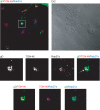Role of the small GTPase Rab27a during herpes simplex virus infection of oligodendrocytic cells
- PMID: 23164453
- PMCID: PMC3554593
- DOI: 10.1186/1471-2180-12-265
Role of the small GTPase Rab27a during herpes simplex virus infection of oligodendrocytic cells
Abstract
Background: The morphogenesis of herpes simplex virus type 1 (HSV-1) comprises several events, of which some are not completely understood. It has been shown that HSV-1 glycoproteins accumulate in the trans-Golgi network (TGN) and in TGN-derived vesicles. It is also accepted that HSV-1 acquires its final morphology through a secondary envelopment by budding into TGN-derived vesicles coated with viral glycoproteins and tegument proteins. Nevertheless, several aspects of this process remain elusive. The small GTPase Rab27a has been implicated in regulated exocytosis, and it seems to play a key role in certain membrane trafficking events. Rab27a also seems to be required for human cytomegalovirus assembly. However, despite the involvement of various Rab GTPases in HSV-1 envelopment, there is, to date, no data reported on the role of Rab27a in HSV-1 infection.
Results: Herein, we show that Rab27a colocalized with GHSV-UL46, a tegument-tagged green fluorescent protein-HSV-1, in the TGN. In fact, this small GTPase colocalized with viral glycoproteins gH and gD in that compartment. Functional analysis through Rab27a depletion showed a significant decrease in the number of infected cells and viral production in Rab27a-silenced cells.
Conclusions: Altogether, our results indicate that Rab27a plays an important role in HSV-1 infection of oligodendrocytic cells.
Figures








